Mary Quattlebaum's Blog, page 15
November 23, 2015
DO NOT OPEN THIS BOX!
guest post by Timothy Young
Boxes are incredibly useful and somewhat mystical things. Without boxes, birthdays would be less exciting, we’d have a heck of a time on moving day and Schrodinger would have no problem knowing if his cat were dead or alive. Thankfully, we have boxes and my new picture book, Do Not Open The Box!, is a story about one boy and a box. Benny comes across a very large box with a sign on it that says “Do Not Open.” Benny is curious and thinks of all kinds of things that could be in the box, both good and bad, and has to decide whether to give in to temptation and open it.

There are many books about boxes and their plots are as different as the number of things you could find in a box. For example, Too Many Toys by David Shannon, Not A Box by Antoinette Portis or The Birthday Box by Leslie Patricelli tell very unique stories about what kids do with boxes.
Writing Exercise:Put a box on a table. Ask students to write two lists of what they think could be in the box. One list will be things that would realistically be in the box. The other will be a fantasy list of what they’d like to be in the box. Examine the differences between the possible and the impossible.
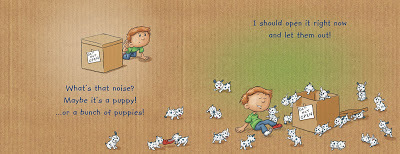
Art Exercise:The students can pick an item from each list and draw a picture of a dragon eating cupcakes or monsters reading textbooks.
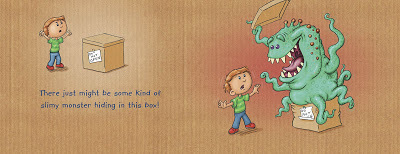
 Timothy Young has been an animator, puppet maker, toy designer, sculptor, art director and graphic designer. He’s designed for Pee-Wee’s Playhouse, the Muppets, The Simpsons, Disney, and Universal Studios. Tim is the author/illustrator of 6 picture books including Shadows On My Wall, The Angry Little Puffin and the highly acclaimedI Hate Picture Books!. His latest, Do Not Open The Box, will be released on January 23rd, 2016. He lives with his family on the Eastern Shore of Maryland. Find out more about him and his books at www.creaturesandcharacters.com
Timothy Young has been an animator, puppet maker, toy designer, sculptor, art director and graphic designer. He’s designed for Pee-Wee’s Playhouse, the Muppets, The Simpsons, Disney, and Universal Studios. Tim is the author/illustrator of 6 picture books including Shadows On My Wall, The Angry Little Puffin and the highly acclaimedI Hate Picture Books!. His latest, Do Not Open The Box, will be released on January 23rd, 2016. He lives with his family on the Eastern Shore of Maryland. Find out more about him and his books at www.creaturesandcharacters.com
Boxes are incredibly useful and somewhat mystical things. Without boxes, birthdays would be less exciting, we’d have a heck of a time on moving day and Schrodinger would have no problem knowing if his cat were dead or alive. Thankfully, we have boxes and my new picture book, Do Not Open The Box!, is a story about one boy and a box. Benny comes across a very large box with a sign on it that says “Do Not Open.” Benny is curious and thinks of all kinds of things that could be in the box, both good and bad, and has to decide whether to give in to temptation and open it.

There are many books about boxes and their plots are as different as the number of things you could find in a box. For example, Too Many Toys by David Shannon, Not A Box by Antoinette Portis or The Birthday Box by Leslie Patricelli tell very unique stories about what kids do with boxes.
Writing Exercise:Put a box on a table. Ask students to write two lists of what they think could be in the box. One list will be things that would realistically be in the box. The other will be a fantasy list of what they’d like to be in the box. Examine the differences between the possible and the impossible.

Art Exercise:The students can pick an item from each list and draw a picture of a dragon eating cupcakes or monsters reading textbooks.

 Timothy Young has been an animator, puppet maker, toy designer, sculptor, art director and graphic designer. He’s designed for Pee-Wee’s Playhouse, the Muppets, The Simpsons, Disney, and Universal Studios. Tim is the author/illustrator of 6 picture books including Shadows On My Wall, The Angry Little Puffin and the highly acclaimedI Hate Picture Books!. His latest, Do Not Open The Box, will be released on January 23rd, 2016. He lives with his family on the Eastern Shore of Maryland. Find out more about him and his books at www.creaturesandcharacters.com
Timothy Young has been an animator, puppet maker, toy designer, sculptor, art director and graphic designer. He’s designed for Pee-Wee’s Playhouse, the Muppets, The Simpsons, Disney, and Universal Studios. Tim is the author/illustrator of 6 picture books including Shadows On My Wall, The Angry Little Puffin and the highly acclaimedI Hate Picture Books!. His latest, Do Not Open The Box, will be released on January 23rd, 2016. He lives with his family on the Eastern Shore of Maryland. Find out more about him and his books at www.creaturesandcharacters.com
Published on November 23, 2015 14:00
November 16, 2015
RISK AND REWARD
Guest Post by Debbie Levy
Visitors to this blog who are in the teaching and reading professions know—better than I—of the movement among literacy experts to give children more so-called “risky” texts to read, listen to, and discuss. By definition, risky texts raise difficult issues, and these educators say that kids can handle them, when the books are age-appropriate. Risky texts might raise feelings of sadness, guilt, or anger, even among young readers. That’s the risky part. But in my view, and the view of many others, the benefits can far outweigh the drawbacks. Quoting an academic paper I read recently: risky texts “can help students learn about . . . injustices, make connections to their own lives and broader social contexts, and consider potential actions to redress these injustices.” They also promote empathy and a moral sensibility to the sufferings of others.
I didn’t set out to write a “risky book” when I wrote We Shall Overcome: The Story of a Song, a picture book about how voices upon voices over years upon years built up this famous song like a collage. The book describes how this song came to be and how it helped the people who sang it while they fought against injustice—and how it still helps people today. The book starts like this:
Back in slavery times—when enslaved people worked long dayswith no pay and no say,no freedom, no fairness,no choice and no chance—the people sang.They suffered, yet they sang—to soothe the hurt,to fight the cruelty,to declare that—yes!—they were human beings. Each spread has lyrics from the song, or precursor of the song. The book travels through different historical events and times in which the song evolved and played a part. I didn’t think of it as a risky book. But this past August I received a letter about the book—about this page: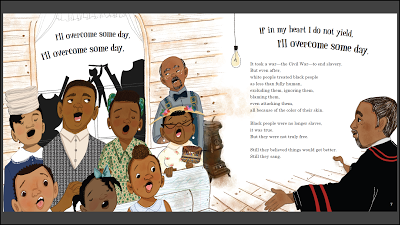
The text, if you can’t read it in the image, reads as follows:It took a war—the Civil War—to end slavery.But even after,white people treated black peopleas less than fully human,excluding them, ignoring them,blaming them,even attacking them,all because of the color of their skin.Black people were no longer slaves,it was true.But they were not truly free.Still they believed things would get better.Still they sang. As I said, I received a letter. “Hello,” the letter began, “at work we had a book fair, and I purchased your book We Shall Overcome. My mouth dropped on page 7, and I had to put the book down! . . . Why didn’t it just say, after the civil war, ‘people’ still had a hard time getting along or understanding. Why did you have to be so . . . I don’t have words. . . . I thought the book would be shocking to read to my grandson.” Now, I wouldn’t want to take the approach this letter-writer wanted: to suggest that the problem after the Civil War was that people had a hard time getting along. The problem was racism, and although this book doesn’t use –ism words, I wanted readers to know that white-on-black prejudice was the problem. It wasn’t a matter of simply not getting along. Reasonable minds can certainly differ on what a particular child should read. And, of course, a grandmother should choose what she’s comfortable reading to her grandchild. But I do want children to know and to face truths, even uncomfortable ones. I think they are capable. And I think that facing truths is something that goes on, and should go on, in our schools. Which brings me to using this book in the classroom—both as part of social justice education and to get kids writing about how to respond to injustice. In my own interactions with young students around this book, I’ve found that they don’t necessarily grasp the notion of racial bigotry at first. (Not a bad form of ignorance!) But we do need to introduce them to this part of our history, which, as we adults know, isn’t really a thing of the past. So, with the younger students, I like to begin by talking about unfairness, with some “what if?” questions. What if you couldn’t go to your favorite park because of your hair color? Had to sit apart in school or on bus or in movies because you go to a different church—or don’t go to church? Couldn’t go to the place where they serve the best ice cream in town because only blue people can and you are orange? They giggle, but they get it. And then I talk about how, not so long ago, restaurants could refuse to serve you a meal if you were African American. I explain that, in those days, if you were African American, if you were Mexican American—you could not drink out of the same water fountains as white people in some parts of the country. (I share photographs of these and other segregationist practices. They are easy to find on the Internet.) So, I ask the kids, what’s unfair about all this? Write a letter to persuade the people in charge—the owner of a restaurant or theater or ice cream parlor, the superintendent of a county park, the president of the bus company—to allow equal access to these places. And I ask: if you were being treated so unfairly, or if someone you loved were, how would you feel? Write a diary entry about this. We can agree that being treating this unfairly could make you so angry and frustrated that you might want to fight. But fighting with your fists could create even more problems for you and it probably wouldn’t get you what you wanted. So, I ask the students, how can you fight with your brain? This is a good question to discuss in a group. And it’s a good question to lead into reading my book, because the story of the song “We Shall Overcome” is in part the story of the ways people in the civil rights movement thoughtfully fought against race discrimination. After reading the book and after singing the song, I ask: why was singing part of the fight against unfairness? (I have my answers. Singing shows the people who are treating you unfairly that you are strong, that you are a human being, and that you will be heard. And singing can give you courage and can lift your spirits—especially if you’re singing with others. But I want to know what the students think.) Two more writing activities after reading the book: Write a journal entry from the point of view of a person who lived through one of the time periods in the story and timeline. It can be someone who participated in the struggle. It can be someone on the sidelines. Someone black, someone white. Finally: Write your own new verses for the song, verses that respond to problems you see in your or community today. (Bullying comes to mind. Social shaming, too. But let’s see what’s on the students’ minds!) This last activity is my favorite. The song’s structure is simplicity itself, so everyone can succeed at this. I like encouraging the idea that everyone can author his or own lyrics about fighting injustice. And the lyrics can lead to a discussion of these difficult issues. The new verses, like “We will stand with you,” or “We are on your side,” are among the rewards for taking on a “risky” subject.
 Debbie Levy is the author of more than twenty books of fiction, nonfiction, and poetry for young people, including the Jane Addams Award Honor book, We Shall Overcome: The Story of a Song, and the Sydney Taylor Notable book, The Year of Goodbyes. Visit http://debbielevybooks.com/
Debbie Levy is the author of more than twenty books of fiction, nonfiction, and poetry for young people, including the Jane Addams Award Honor book, We Shall Overcome: The Story of a Song, and the Sydney Taylor Notable book, The Year of Goodbyes. Visit http://debbielevybooks.com/
Visitors to this blog who are in the teaching and reading professions know—better than I—of the movement among literacy experts to give children more so-called “risky” texts to read, listen to, and discuss. By definition, risky texts raise difficult issues, and these educators say that kids can handle them, when the books are age-appropriate. Risky texts might raise feelings of sadness, guilt, or anger, even among young readers. That’s the risky part. But in my view, and the view of many others, the benefits can far outweigh the drawbacks. Quoting an academic paper I read recently: risky texts “can help students learn about . . . injustices, make connections to their own lives and broader social contexts, and consider potential actions to redress these injustices.” They also promote empathy and a moral sensibility to the sufferings of others.

I didn’t set out to write a “risky book” when I wrote We Shall Overcome: The Story of a Song, a picture book about how voices upon voices over years upon years built up this famous song like a collage. The book describes how this song came to be and how it helped the people who sang it while they fought against injustice—and how it still helps people today. The book starts like this:

Back in slavery times—when enslaved people worked long dayswith no pay and no say,no freedom, no fairness,no choice and no chance—the people sang.They suffered, yet they sang—to soothe the hurt,to fight the cruelty,to declare that—yes!—they were human beings. Each spread has lyrics from the song, or precursor of the song. The book travels through different historical events and times in which the song evolved and played a part. I didn’t think of it as a risky book. But this past August I received a letter about the book—about this page:

The text, if you can’t read it in the image, reads as follows:It took a war—the Civil War—to end slavery.But even after,white people treated black peopleas less than fully human,excluding them, ignoring them,blaming them,even attacking them,all because of the color of their skin.Black people were no longer slaves,it was true.But they were not truly free.Still they believed things would get better.Still they sang. As I said, I received a letter. “Hello,” the letter began, “at work we had a book fair, and I purchased your book We Shall Overcome. My mouth dropped on page 7, and I had to put the book down! . . . Why didn’t it just say, after the civil war, ‘people’ still had a hard time getting along or understanding. Why did you have to be so . . . I don’t have words. . . . I thought the book would be shocking to read to my grandson.” Now, I wouldn’t want to take the approach this letter-writer wanted: to suggest that the problem after the Civil War was that people had a hard time getting along. The problem was racism, and although this book doesn’t use –ism words, I wanted readers to know that white-on-black prejudice was the problem. It wasn’t a matter of simply not getting along. Reasonable minds can certainly differ on what a particular child should read. And, of course, a grandmother should choose what she’s comfortable reading to her grandchild. But I do want children to know and to face truths, even uncomfortable ones. I think they are capable. And I think that facing truths is something that goes on, and should go on, in our schools. Which brings me to using this book in the classroom—both as part of social justice education and to get kids writing about how to respond to injustice. In my own interactions with young students around this book, I’ve found that they don’t necessarily grasp the notion of racial bigotry at first. (Not a bad form of ignorance!) But we do need to introduce them to this part of our history, which, as we adults know, isn’t really a thing of the past. So, with the younger students, I like to begin by talking about unfairness, with some “what if?” questions. What if you couldn’t go to your favorite park because of your hair color? Had to sit apart in school or on bus or in movies because you go to a different church—or don’t go to church? Couldn’t go to the place where they serve the best ice cream in town because only blue people can and you are orange? They giggle, but they get it. And then I talk about how, not so long ago, restaurants could refuse to serve you a meal if you were African American. I explain that, in those days, if you were African American, if you were Mexican American—you could not drink out of the same water fountains as white people in some parts of the country. (I share photographs of these and other segregationist practices. They are easy to find on the Internet.) So, I ask the kids, what’s unfair about all this? Write a letter to persuade the people in charge—the owner of a restaurant or theater or ice cream parlor, the superintendent of a county park, the president of the bus company—to allow equal access to these places. And I ask: if you were being treated so unfairly, or if someone you loved were, how would you feel? Write a diary entry about this. We can agree that being treating this unfairly could make you so angry and frustrated that you might want to fight. But fighting with your fists could create even more problems for you and it probably wouldn’t get you what you wanted. So, I ask the students, how can you fight with your brain? This is a good question to discuss in a group. And it’s a good question to lead into reading my book, because the story of the song “We Shall Overcome” is in part the story of the ways people in the civil rights movement thoughtfully fought against race discrimination. After reading the book and after singing the song, I ask: why was singing part of the fight against unfairness? (I have my answers. Singing shows the people who are treating you unfairly that you are strong, that you are a human being, and that you will be heard. And singing can give you courage and can lift your spirits—especially if you’re singing with others. But I want to know what the students think.) Two more writing activities after reading the book: Write a journal entry from the point of view of a person who lived through one of the time periods in the story and timeline. It can be someone who participated in the struggle. It can be someone on the sidelines. Someone black, someone white. Finally: Write your own new verses for the song, verses that respond to problems you see in your or community today. (Bullying comes to mind. Social shaming, too. But let’s see what’s on the students’ minds!) This last activity is my favorite. The song’s structure is simplicity itself, so everyone can succeed at this. I like encouraging the idea that everyone can author his or own lyrics about fighting injustice. And the lyrics can lead to a discussion of these difficult issues. The new verses, like “We will stand with you,” or “We are on your side,” are among the rewards for taking on a “risky” subject.
 Debbie Levy is the author of more than twenty books of fiction, nonfiction, and poetry for young people, including the Jane Addams Award Honor book, We Shall Overcome: The Story of a Song, and the Sydney Taylor Notable book, The Year of Goodbyes. Visit http://debbielevybooks.com/
Debbie Levy is the author of more than twenty books of fiction, nonfiction, and poetry for young people, including the Jane Addams Award Honor book, We Shall Overcome: The Story of a Song, and the Sydney Taylor Notable book, The Year of Goodbyes. Visit http://debbielevybooks.com/
Published on November 16, 2015 14:00
November 9, 2015
CHARACTER DOODLES
by Joan Waites
A fun and simple art project to create with your students is a page of character doodles.
Starting with a blank sheet of paper, randomly draw with a permanent black marker, shapes, swirls and varied lines till the page is almost filled. If desired, leave one larger white space to be used later for writing. To make the project more challenging for older students, have them draw with their non-dominant hand, or with their eyes closed.
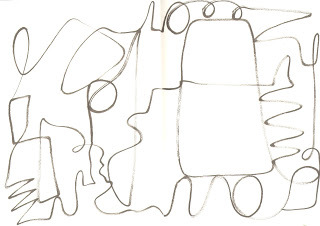
Next, fill in the shapes created on the page using various colors. Use a medium that can be drawn on top of when dry such as watercolor, markers, acrylic paint or colored pencils rather than something waxy like oil pastel or crayons.
Once the shapes are filled in with color, ask students to look closely at the art. Can they see a face or an animal? A funny creature? A building or perhaps a tree? Using black or other colored markers, have students add facial details, designs, and embellishments to the characters and objects that emerge on the page.
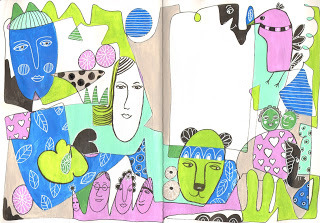
To add a writing exercise, have students use the large white space on the page to compose a short story, poem, or character study about one or more of their characters.
Happy doodling!
www.joanwaites.com
A fun and simple art project to create with your students is a page of character doodles.
Starting with a blank sheet of paper, randomly draw with a permanent black marker, shapes, swirls and varied lines till the page is almost filled. If desired, leave one larger white space to be used later for writing. To make the project more challenging for older students, have them draw with their non-dominant hand, or with their eyes closed.

Next, fill in the shapes created on the page using various colors. Use a medium that can be drawn on top of when dry such as watercolor, markers, acrylic paint or colored pencils rather than something waxy like oil pastel or crayons.
Once the shapes are filled in with color, ask students to look closely at the art. Can they see a face or an animal? A funny creature? A building or perhaps a tree? Using black or other colored markers, have students add facial details, designs, and embellishments to the characters and objects that emerge on the page.

To add a writing exercise, have students use the large white space on the page to compose a short story, poem, or character study about one or more of their characters.
Happy doodling!
www.joanwaites.com
Published on November 09, 2015 14:00
November 2, 2015
Writing Connections with Jon Scieszka
by Mary Quattlebaum
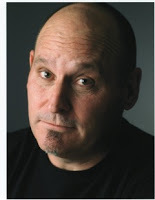 Make writing and science fun with Jon Scieszka! His latest book is the third in his zany Frank Einstein series. In Frank Einstein and the Brainturbo, students can hang out with Frank’s two wacky robot sidekicks and learn about the human body. In an interviewwith the KidsPost section of the WashingtonPost, Scieszka talks about encouraging curiosity and his favorite facts about the body.
Make writing and science fun with Jon Scieszka! His latest book is the third in his zany Frank Einstein series. In Frank Einstein and the Brainturbo, students can hang out with Frank’s two wacky robot sidekicks and learn about the human body. In an interviewwith the KidsPost section of the WashingtonPost, Scieszka talks about encouraging curiosity and his favorite facts about the body.
MAKE YOUR OWN HUMAN: Frank creates a kind of super-charged brain. As a class, students might create their own human.

Research: Assign each student a certain part of the human body to research. Ask each to find and write down three facts for his or her body part.
Writing: Ask each student to write down two things that might happen if his particular part of the body were super-charged or made bigger or better than real life? What would that body part then be able to do? Ask each student to draw a picture of his/her super-charged body part. What might happen if a villain tried to grab and run away with it? Why would a villain want it? How might the student (as a zany kid scientist) save it?
Sharing: Teacher might have a silhouette of the human body on the bulletin board, and students might post one or all of their true facts on the bulletin board. In this way, students can learn about the intricate work of many organs and body parts.
www.maryquattlebaum.com
 Make writing and science fun with Jon Scieszka! His latest book is the third in his zany Frank Einstein series. In Frank Einstein and the Brainturbo, students can hang out with Frank’s two wacky robot sidekicks and learn about the human body. In an interviewwith the KidsPost section of the WashingtonPost, Scieszka talks about encouraging curiosity and his favorite facts about the body.
Make writing and science fun with Jon Scieszka! His latest book is the third in his zany Frank Einstein series. In Frank Einstein and the Brainturbo, students can hang out with Frank’s two wacky robot sidekicks and learn about the human body. In an interviewwith the KidsPost section of the WashingtonPost, Scieszka talks about encouraging curiosity and his favorite facts about the body.MAKE YOUR OWN HUMAN: Frank creates a kind of super-charged brain. As a class, students might create their own human.

Research: Assign each student a certain part of the human body to research. Ask each to find and write down three facts for his or her body part.
Writing: Ask each student to write down two things that might happen if his particular part of the body were super-charged or made bigger or better than real life? What would that body part then be able to do? Ask each student to draw a picture of his/her super-charged body part. What might happen if a villain tried to grab and run away with it? Why would a villain want it? How might the student (as a zany kid scientist) save it?
Sharing: Teacher might have a silhouette of the human body on the bulletin board, and students might post one or all of their true facts on the bulletin board. In this way, students can learn about the intricate work of many organs and body parts.
www.maryquattlebaum.com
Published on November 02, 2015 14:00
October 26, 2015
Words Flap From Her
by Karen Leggett Abouraya
Andrea Davis Pinkney writes in her author’s note that The Red Pencil follows “one child’s journey through grief and possibility” during the scourge of civil war in Darfur, Sudan, in 2004. Through Pinkney’s vivid use of poetry, metaphor, and descriptive language Amira comes alive. We are touched by the simple beauty of her life before the war and the often frightening challenges she struggles to overcome when her broken family must flee to a refugee camp.
 Many older students will find the entire book compelling, but it is possible to share a few poems or even phrases as powerful writing prompts. Ask students to choose a writing activity based on The Red Pencil:
Many older students will find the entire book compelling, but it is possible to share a few poems or even phrases as powerful writing prompts. Ask students to choose a writing activity based on The Red Pencil:
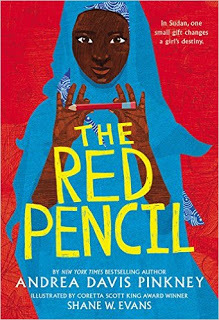
1) Describe a friend or relative with the kind of vivid language Pinkney uses.
Amira writes of the mother of her good friend:
“Words flap from herlike giddy chickens escaping their pen.She is so squawky, that woman.”
Or the impish boy Gamal, who could use an old soup can for a soccer ball.
“Gamal:wide-open eyes,smiling,seeing possibilitiesin ‘icken oodle’and broken bottles.
Gapped teeth,ready to take a biteout of anything thattastes like stickymischief.”
2) Describe something simple that you very much want or need - and imagine what happens when you get it. For Amira, it’s a rare bottle of Fanta Orange soda, shared with her younger sister Leila and Gamal.
“They pass the pop-treat back and forth,licking their lips,tasting the sweet on their teeth,savoring.
Then Gamal and Leila grant another surprise.
They leave the final guzzle for me,letting me hug my bottle,not a broken dolly,but a sugar-bright memoryof shared joy.”
There are people as “closed-minded as donkeys/who will not turn their eyes to see anything/beyond what is right in front of them.” When a sandstorm twists through the air, “the sky is spinning a rope.” There are nights when the moon, “a glowing lady, will not cooperate./That milk-bellied lady/refuses to reveal herself.”
Pinkney wants her poetry to “encourage young readers to express their own emtions and troubles, and to find comfort in the most upsetting circumstances.” It doesn’t matter if students write in verse or prose. The goal is to use words that are vivid and memorable, making the people or events they describe so real they might be right in your own town.
The Red Pencil, by Andrew Davis Pinkney and illustrated by Shane W. Evans, is the winner of the 2015 Children’s Africana Book Award, given to the best children’s and young adult books about Africa. More information at africaaccessreview.org including the Read Africa Challenge.
http://childrensbookguild.org/karen-leggett-abouraya
Andrea Davis Pinkney writes in her author’s note that The Red Pencil follows “one child’s journey through grief and possibility” during the scourge of civil war in Darfur, Sudan, in 2004. Through Pinkney’s vivid use of poetry, metaphor, and descriptive language Amira comes alive. We are touched by the simple beauty of her life before the war and the often frightening challenges she struggles to overcome when her broken family must flee to a refugee camp.
 Many older students will find the entire book compelling, but it is possible to share a few poems or even phrases as powerful writing prompts. Ask students to choose a writing activity based on The Red Pencil:
Many older students will find the entire book compelling, but it is possible to share a few poems or even phrases as powerful writing prompts. Ask students to choose a writing activity based on The Red Pencil:

1) Describe a friend or relative with the kind of vivid language Pinkney uses.
Amira writes of the mother of her good friend:
“Words flap from herlike giddy chickens escaping their pen.She is so squawky, that woman.”
Or the impish boy Gamal, who could use an old soup can for a soccer ball.
“Gamal:wide-open eyes,smiling,seeing possibilitiesin ‘icken oodle’and broken bottles.
Gapped teeth,ready to take a biteout of anything thattastes like stickymischief.”
2) Describe something simple that you very much want or need - and imagine what happens when you get it. For Amira, it’s a rare bottle of Fanta Orange soda, shared with her younger sister Leila and Gamal.
“They pass the pop-treat back and forth,licking their lips,tasting the sweet on their teeth,savoring.
Then Gamal and Leila grant another surprise.
They leave the final guzzle for me,letting me hug my bottle,not a broken dolly,but a sugar-bright memoryof shared joy.”
There are people as “closed-minded as donkeys/who will not turn their eyes to see anything/beyond what is right in front of them.” When a sandstorm twists through the air, “the sky is spinning a rope.” There are nights when the moon, “a glowing lady, will not cooperate./That milk-bellied lady/refuses to reveal herself.”
Pinkney wants her poetry to “encourage young readers to express their own emtions and troubles, and to find comfort in the most upsetting circumstances.” It doesn’t matter if students write in verse or prose. The goal is to use words that are vivid and memorable, making the people or events they describe so real they might be right in your own town.
The Red Pencil, by Andrew Davis Pinkney and illustrated by Shane W. Evans, is the winner of the 2015 Children’s Africana Book Award, given to the best children’s and young adult books about Africa. More information at africaaccessreview.org including the Read Africa Challenge.
http://childrensbookguild.org/karen-leggett-abouraya
Published on October 26, 2015 14:00
October 19, 2015
MAKE UP YOUR MIND WITH DR. SEUSS!
by Jacqueline Jules
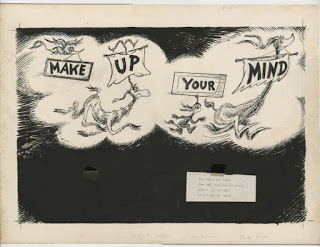
What child (or adult) has not had trouble making up his or her mind? Dr. Seuss in his posthumously published book What Pet Should I Get? delightfully captures this common dilemma in trademark Seuss rhyme and illustrations. This picture book would be a perfect read aloud and prompt for a personal narrative writing exercise.

· Can you describe a time when you had trouble making up your mind?· Did you ever end up with nothing because you couldn’t choose just one thing? · What factors made your decision difficult? · Did you make your final decision alone or with the help of someone else? · How did you feel when you finally chose?· Did you regret your decision later?
Students can brainstorm as a class with the questions above before writing individual essays. Encourage students to write about situations beyond choosing a pet. Make lists of all the things people make decisions about on a daily basis. ie: clothes, food, television shows. Discuss times when students have made a decision to please someone else, like buying a gift or planning a party. Name important decisions people make during their lives. ie: choosing a school, a house, a car, a job, a spouse. Decision making is an integral part of our lives and something we do on a daily, even hourly basis.
And trouble making up your mind is an experience students from all backgrounds can relate to, making it a slam dunk prompt for writing personal narratives.
Happy Writing!
www.jacquelinejules.com

What child (or adult) has not had trouble making up his or her mind? Dr. Seuss in his posthumously published book What Pet Should I Get? delightfully captures this common dilemma in trademark Seuss rhyme and illustrations. This picture book would be a perfect read aloud and prompt for a personal narrative writing exercise.

· Can you describe a time when you had trouble making up your mind?· Did you ever end up with nothing because you couldn’t choose just one thing? · What factors made your decision difficult? · Did you make your final decision alone or with the help of someone else? · How did you feel when you finally chose?· Did you regret your decision later?
Students can brainstorm as a class with the questions above before writing individual essays. Encourage students to write about situations beyond choosing a pet. Make lists of all the things people make decisions about on a daily basis. ie: clothes, food, television shows. Discuss times when students have made a decision to please someone else, like buying a gift or planning a party. Name important decisions people make during their lives. ie: choosing a school, a house, a car, a job, a spouse. Decision making is an integral part of our lives and something we do on a daily, even hourly basis.
And trouble making up your mind is an experience students from all backgrounds can relate to, making it a slam dunk prompt for writing personal narratives.
Happy Writing!
www.jacquelinejules.com
Published on October 19, 2015 14:00
October 12, 2015
Halloween Writing Challenge: What’s Your Wand?
by Alison Ashley Formento
Wizards carry wands, Jedi knights use light sabers, and superheroes sometimes wear capes. The chances are very good that you’ll see a few wands, light sabers, and capes this Halloween. Popular wizards, Jedi knights, and superheroes were first created by authors or writers of comics or screenplays. Clothing items and props, that characters carry or wear, not only become useful in key or climatic moments in a story but these elements are part of what make characters memorable for readers.

Writing challenge: What’s your wand?
Harry Potter needs his wand to battle evil wizards and help his friends at Hogwarts.
Look around your school.Pick one item you see or use every day and imagine it has special super powers.Write a one-page (or longer) story using this item to help save your class from danger.
Example: The clouds covered the playground at recess, but it wasn’t rain. I was still in the cafeteria, finishing my lunch when my special tray began to glow and rattle around on the table. “Uh, oh!” The peas spilled out and rolled around in front of my eyes. Trouble! A giant roar shook our entire school building. I flipped my food tray over and gripped the edge and raced out to the playground. The tray molded into a fierce Frisbee in my hand. I was ready to face the dark dragon roaring at my friends.
To be continued…
www.alisonashleyformento.com
Wizards carry wands, Jedi knights use light sabers, and superheroes sometimes wear capes. The chances are very good that you’ll see a few wands, light sabers, and capes this Halloween. Popular wizards, Jedi knights, and superheroes were first created by authors or writers of comics or screenplays. Clothing items and props, that characters carry or wear, not only become useful in key or climatic moments in a story but these elements are part of what make characters memorable for readers.

Writing challenge: What’s your wand?
Harry Potter needs his wand to battle evil wizards and help his friends at Hogwarts.
Look around your school.Pick one item you see or use every day and imagine it has special super powers.Write a one-page (or longer) story using this item to help save your class from danger.
Example: The clouds covered the playground at recess, but it wasn’t rain. I was still in the cafeteria, finishing my lunch when my special tray began to glow and rattle around on the table. “Uh, oh!” The peas spilled out and rolled around in front of my eyes. Trouble! A giant roar shook our entire school building. I flipped my food tray over and gripped the edge and raced out to the playground. The tray molded into a fierce Frisbee in my hand. I was ready to face the dark dragon roaring at my friends.
To be continued…
www.alisonashleyformento.com
Published on October 12, 2015 14:00
October 5, 2015
Illustrated Quotes
by Joan Waites
In many of my older blog posts, I've talked about exercises and projects for students which incorporate art and words. Picture books, short stories and poems all provide inspiration for countless ways words and art can be combined.
Even more challenging, is illustrating a quote that may only be one or two sentences long. Characters, setting, and action are not always described in these few short lines. A quote can be illustrated with colors, symbols, drawings, photographs or collage. The art will not necessarily depict the quote word for word, but convey it's overall meaning, emotion, or advice.
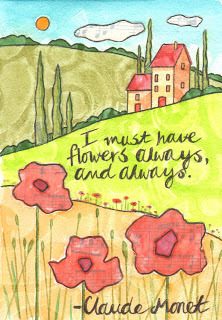 Art by Joan Waites
Art by Joan Waites
For a classroom exercise, have your students pick a quote from a favorite artist, author, pop culture or historical figure. Provide a variety of materials students can use to illustrate their quote. Basic art supplies, magazines, found papers, fabric and 3-D objects can all be used. Remind students to choose imagery, colors, and composition to illuminate what was said, or the person who said it. Have students incorporate the actual quote into their art work, or paste it below their piece.
Happy Fall!
www.joanwaites.com
In many of my older blog posts, I've talked about exercises and projects for students which incorporate art and words. Picture books, short stories and poems all provide inspiration for countless ways words and art can be combined.
Even more challenging, is illustrating a quote that may only be one or two sentences long. Characters, setting, and action are not always described in these few short lines. A quote can be illustrated with colors, symbols, drawings, photographs or collage. The art will not necessarily depict the quote word for word, but convey it's overall meaning, emotion, or advice.
 Art by Joan Waites
Art by Joan WaitesFor a classroom exercise, have your students pick a quote from a favorite artist, author, pop culture or historical figure. Provide a variety of materials students can use to illustrate their quote. Basic art supplies, magazines, found papers, fabric and 3-D objects can all be used. Remind students to choose imagery, colors, and composition to illuminate what was said, or the person who said it. Have students incorporate the actual quote into their art work, or paste it below their piece.
Happy Fall!
www.joanwaites.com
Published on October 05, 2015 14:00
September 28, 2015
Writing Connections with Science
by Mary Quattlebaum
How to connect writing and science? Both are important areas for learning for students of all ages. At the same time that you teach one, you might look for opportunities to reinforce learning in the other.
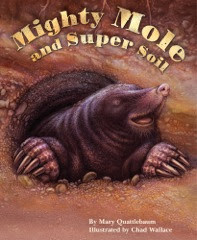
The website of the publisher of my new nonfiction picture book, Mighty Mole and Super Soil (ages 4-9), features an article with activities related to the book (including making a dirt cake) and Common Core-related projects.
Here are two activities that connect writing with science:
DIRT LETTERS: The United Nations named 2015 the International Year of Soils, in honor of this important resource. Soil is vital to the health of the planet, but most humans rarely think of it because they can’t see it.Classroom discussion: Have students look around the room and out the windows and brainstorm ways that soil is important to life. Writing: Young elementary-aged children might choose one of those ways and write and illustrate a letter thanking soil for what it has done/gives and how that particular child has benefitted. Older children might send their letters to a congressman.Sharing: Letters might be posted on a classroom bulletin board, to help celebrate World Soil Day on December 5 (as well as the year-long celebration). Also the class as a whole might plant a seed or transplant a houseplant into a special pot so that students can feel soil and experience it through many of their senses. (Chad Wallace brings the underground world to vivid life through his illustrations for Mighty Mole and Super Soil, and students might look at them as they illustrate their letters.)Playing with Font/Letter Shapes: Patty Arnold, the book’s designer, worked carefully with the font so that the title and words in the main story look “gritty,” as if they’re fashioned from soil. As Patty says, the shape and design of the words can help to create a picture and enhance the story. Students might make some of their words (such as “soil”) look as if they’re made of dirt, perhaps by using a brown crayon when writing that one word.
ARGUE ON PAPER: Mighty Mole and Super Soilgrew out of an ongoing discussion with one of my brothers about moles. I was Team Mole, appreciating the shy mammal in our backyard. Moles mix and contribute to healthy soil. My brother was Team No Mole, irritated by the ridges and molehills in his plush lawn. He called the mole a pest! Doing the research to persuade him otherwise gave me the idea to write this book, which I dedicated to him. J Classroom discussion: Ask students to list creatures that many people label as pests (specific types of animals or weeds, perhaps). Why are they considered pests? What do they do that disturbs humans?Research and Prep: Ask students to each choose one of these “pests” and to research its benefits (find at least three). Then ask them to close their eyes and “become” this pesky animal or plant. What does it see, hear, smell, taste, and feel? What is its world like?Writing: Continue to pretend to be that pesky animal or plant, and write a letter from it to someone (the world at large, an exterminator, a mole catcher, human parent, etc.) to persuade that person that it is not a pest. Why should this creature or plant NOT be destroyed or removed? Have students work in pairs to peer review one another’s work and enhance the persuasiveness.Share: Ask for volunteers to share and encourage students to send their letters to the person or to a newspaper editor or organization.
www.maryquattlebaum.com
How to connect writing and science? Both are important areas for learning for students of all ages. At the same time that you teach one, you might look for opportunities to reinforce learning in the other.

The website of the publisher of my new nonfiction picture book, Mighty Mole and Super Soil (ages 4-9), features an article with activities related to the book (including making a dirt cake) and Common Core-related projects.
Here are two activities that connect writing with science:
DIRT LETTERS: The United Nations named 2015 the International Year of Soils, in honor of this important resource. Soil is vital to the health of the planet, but most humans rarely think of it because they can’t see it.Classroom discussion: Have students look around the room and out the windows and brainstorm ways that soil is important to life. Writing: Young elementary-aged children might choose one of those ways and write and illustrate a letter thanking soil for what it has done/gives and how that particular child has benefitted. Older children might send their letters to a congressman.Sharing: Letters might be posted on a classroom bulletin board, to help celebrate World Soil Day on December 5 (as well as the year-long celebration). Also the class as a whole might plant a seed or transplant a houseplant into a special pot so that students can feel soil and experience it through many of their senses. (Chad Wallace brings the underground world to vivid life through his illustrations for Mighty Mole and Super Soil, and students might look at them as they illustrate their letters.)Playing with Font/Letter Shapes: Patty Arnold, the book’s designer, worked carefully with the font so that the title and words in the main story look “gritty,” as if they’re fashioned from soil. As Patty says, the shape and design of the words can help to create a picture and enhance the story. Students might make some of their words (such as “soil”) look as if they’re made of dirt, perhaps by using a brown crayon when writing that one word.
ARGUE ON PAPER: Mighty Mole and Super Soilgrew out of an ongoing discussion with one of my brothers about moles. I was Team Mole, appreciating the shy mammal in our backyard. Moles mix and contribute to healthy soil. My brother was Team No Mole, irritated by the ridges and molehills in his plush lawn. He called the mole a pest! Doing the research to persuade him otherwise gave me the idea to write this book, which I dedicated to him. J Classroom discussion: Ask students to list creatures that many people label as pests (specific types of animals or weeds, perhaps). Why are they considered pests? What do they do that disturbs humans?Research and Prep: Ask students to each choose one of these “pests” and to research its benefits (find at least three). Then ask them to close their eyes and “become” this pesky animal or plant. What does it see, hear, smell, taste, and feel? What is its world like?Writing: Continue to pretend to be that pesky animal or plant, and write a letter from it to someone (the world at large, an exterminator, a mole catcher, human parent, etc.) to persuade that person that it is not a pest. Why should this creature or plant NOT be destroyed or removed? Have students work in pairs to peer review one another’s work and enhance the persuasiveness.Share: Ask for volunteers to share and encourage students to send their letters to the person or to a newspaper editor or organization.
www.maryquattlebaum.com
Published on September 28, 2015 14:00
September 21, 2015
FICTION VS NONFICTION: REAL OR IMAGINARY?
guest blog by Karen Deans
My two books, Playing to Win and Swing Sisters, are picture book biographies based on the lives of some remarkable women who defied racist and sexist barriers to become champions and superstars in their respective fields. They are written for children who are beginning to identify the differences between fiction and non-fiction writing. I often explain to students that my books are nonfiction, and based on real people and events that actually happened in the past. I talk about the importance of research, because non-fiction depends on it. Fiction, on the other hand, is a story that comes from the author’s imagination. It may require research, too, but it can be as fantastical as an author wants it to be.
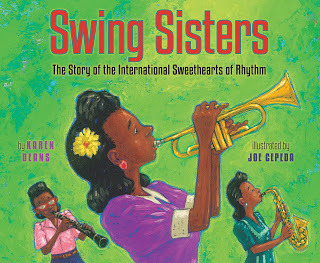 Here are some classroom activities that will help develop and deepen an understanding of fiction and nonfiction writing. Have fun!
Here are some classroom activities that will help develop and deepen an understanding of fiction and nonfiction writing. Have fun!
1. Create a classroom chart: Make two columns with headings: Fiction and Nonfiction. Ask students to brainstorm words that relate to each heading and write them in the correct column. Fiction: poetry, pretend, imaginary, fantasy, talking animals, etc. Nonfiction: facts, biography, history, index, bibliography, etc.
Create a duplicate chart and brainstorm books they have read or will be reading in class. Add them to the new chart in the correct column. Have students describe elements from the first chart that were found in the books they mention. For example, Swing Sisters is both non-fiction and biography. While it doesn’t have an index, it has a bibliography. It is based on facts and not something imagined by the author.
2. Share a Story: Have the children write (or tell) a brief story, either from their imagination or from factual events. Then take turns reading them aloud and let the class determine if they are fiction or nonfiction. Sometimes it is obvious, but sometimes it is not. A fantasy story about a spaceship will obviously be identified as fiction. But someone describing a vacation to the beach might be creating something from her or his imagination. Discuss the elements that lead to their conclusion.
3. Historical Fiction Fun: For older children, depending on their ability, ask them to identify a real event from history, such as the signing of the Declaration of Independence. Ask them to write some factual elements from this event, answering the basic who, what, why, when and where prompts. Next, have them create a character, maybe a cat that sneaks into the room chasing a mouse. What happens next? Does a desk turn over? Is there laughter? Maybe a servant spills a pail of water and shrieks before climbing on top of a chair. How do the real elements mix with the imagined ones?
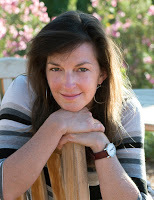 Karen Deans
is a writer, painter and owner of a decorative art business, WoodenTile.com. She has written two picture books for Holiday House, including Swing Sisters: The Story of the International Sweethearts of Rhythm, which came out in March. She has worked as head scenic painter for the children’s theater Adventure Theatre MTC. This work has taken her to Broadway, as set painter for a musical adaptation of the children’s book Three Little Birds, based on the music of Bob Marley. She is the mother of three grown children and lives with her husband and kitty in Bethesda, MD. Visit her at www.karendeans.com
Karen Deans
is a writer, painter and owner of a decorative art business, WoodenTile.com. She has written two picture books for Holiday House, including Swing Sisters: The Story of the International Sweethearts of Rhythm, which came out in March. She has worked as head scenic painter for the children’s theater Adventure Theatre MTC. This work has taken her to Broadway, as set painter for a musical adaptation of the children’s book Three Little Birds, based on the music of Bob Marley. She is the mother of three grown children and lives with her husband and kitty in Bethesda, MD. Visit her at www.karendeans.com
My two books, Playing to Win and Swing Sisters, are picture book biographies based on the lives of some remarkable women who defied racist and sexist barriers to become champions and superstars in their respective fields. They are written for children who are beginning to identify the differences between fiction and non-fiction writing. I often explain to students that my books are nonfiction, and based on real people and events that actually happened in the past. I talk about the importance of research, because non-fiction depends on it. Fiction, on the other hand, is a story that comes from the author’s imagination. It may require research, too, but it can be as fantastical as an author wants it to be.
 Here are some classroom activities that will help develop and deepen an understanding of fiction and nonfiction writing. Have fun!
Here are some classroom activities that will help develop and deepen an understanding of fiction and nonfiction writing. Have fun!1. Create a classroom chart: Make two columns with headings: Fiction and Nonfiction. Ask students to brainstorm words that relate to each heading and write them in the correct column. Fiction: poetry, pretend, imaginary, fantasy, talking animals, etc. Nonfiction: facts, biography, history, index, bibliography, etc.
Create a duplicate chart and brainstorm books they have read or will be reading in class. Add them to the new chart in the correct column. Have students describe elements from the first chart that were found in the books they mention. For example, Swing Sisters is both non-fiction and biography. While it doesn’t have an index, it has a bibliography. It is based on facts and not something imagined by the author.
2. Share a Story: Have the children write (or tell) a brief story, either from their imagination or from factual events. Then take turns reading them aloud and let the class determine if they are fiction or nonfiction. Sometimes it is obvious, but sometimes it is not. A fantasy story about a spaceship will obviously be identified as fiction. But someone describing a vacation to the beach might be creating something from her or his imagination. Discuss the elements that lead to their conclusion.
3. Historical Fiction Fun: For older children, depending on their ability, ask them to identify a real event from history, such as the signing of the Declaration of Independence. Ask them to write some factual elements from this event, answering the basic who, what, why, when and where prompts. Next, have them create a character, maybe a cat that sneaks into the room chasing a mouse. What happens next? Does a desk turn over? Is there laughter? Maybe a servant spills a pail of water and shrieks before climbing on top of a chair. How do the real elements mix with the imagined ones?
 Karen Deans
is a writer, painter and owner of a decorative art business, WoodenTile.com. She has written two picture books for Holiday House, including Swing Sisters: The Story of the International Sweethearts of Rhythm, which came out in March. She has worked as head scenic painter for the children’s theater Adventure Theatre MTC. This work has taken her to Broadway, as set painter for a musical adaptation of the children’s book Three Little Birds, based on the music of Bob Marley. She is the mother of three grown children and lives with her husband and kitty in Bethesda, MD. Visit her at www.karendeans.com
Karen Deans
is a writer, painter and owner of a decorative art business, WoodenTile.com. She has written two picture books for Holiday House, including Swing Sisters: The Story of the International Sweethearts of Rhythm, which came out in March. She has worked as head scenic painter for the children’s theater Adventure Theatre MTC. This work has taken her to Broadway, as set painter for a musical adaptation of the children’s book Three Little Birds, based on the music of Bob Marley. She is the mother of three grown children and lives with her husband and kitty in Bethesda, MD. Visit her at www.karendeans.com
Published on September 21, 2015 14:00
Mary Quattlebaum's Blog
- Mary Quattlebaum's profile
- 22 followers
Mary Quattlebaum isn't a Goodreads Author
(yet),
but they
do have a blog,
so here are some recent posts imported from
their feed.



